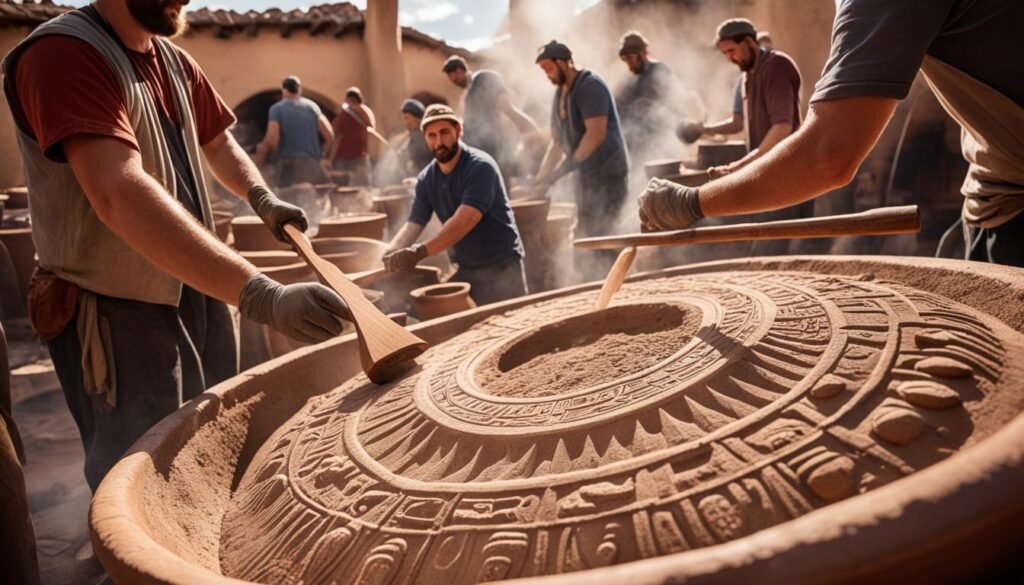The Modern History of Beer is a story full of culture and tradition. We’ll take a trip through time to see how beer went from just being a drink to a big part of our social lives. It started thousands of years ago, with brewing techniques that date back even further. Today, beer is a key part of the craft beer movement, showing its lasting impact on our society.
Looking at the Beer Industry Innovations over the years, we see big changes in brewing technology and trends. For instance, the use of hops in Germany in the 11th century changed the taste and style of beer. The Industrial Revolution then made brewing better and more efficient. This beer timeline shows how the industry has grown and connected us to our brewing past.
Now, the rise of microbreweries and the craft beer movement in the 21st century has changed things again. We’re now part of a community that values the stories and craftsmanship behind beer. The craft beer revolution is all about artisanal styles and personal touches. It’s interesting to see how the industry keeps evolving, influenced by both old traditions and new trends. Brands like Heineken and Asahi show how tastes and society change over time.
Key Takeaways
- Beer production dates back to ancient civilisations, showcasing a rich history.
- Technological advancements significantly impact brewing practices over time.
- The craft beer movement emphasises quality and community engagement.
- Regional influences contribute to diverse beer styles internationally.
- The industry plays a vital role in supporting local economies and job creation.
Introduction to Beer
Beer is one of the oldest drinks known to humans, with a history that’s both rich and fascinating. It has been a key part of many ancient cultures, not just as a drink but also as a symbol of culture. To understand beer, we need to look at how it’s made and the main ingredients used.
Definition of Beer
Beer is an alcoholic drink made from ingredients that are mixed, boiled, and then allowed to ferment. The exact definition can change from country to country, especially in Germany where there are strict rules about what can be used to make it. Traditionally, beer was made from malt, hops, yeast, and water. These ingredients are still the main ones used today, with strict rules to keep the quality high.
Core Ingredients
The main parts of beer are malted barley or other grains, hops, water, and yeast. Each one is important for the taste and character of the beer. Barley gives the sugars for fermentation, hops add bitterness and smell, water affects the taste, and yeast turns the sugars into alcohol. This process creates the wide range of flavours we enjoy in beer.
Learning about beer making involves understanding the seven steps from milling to bottling. Each step is important for the final taste and quality of the beer. For more details on these steps, check out this resource.
| Ingredient | Function |
|---|---|
| Malted Barley | Provides sugars for fermentation |
| Hops | Adds bitterness and aroma |
| Water | Determines overall quality and taste |
| Yeast | Ferments sugars into alcohol |
Early Beginnings of Brewing
The art of brewing beer has been with us since the start of our civilisations. It began with ancient people, who made fermented drinks that helped build social structures and culture. The Development of Brewing Techniques has changed how we enjoy beer today.
Ancient Civilisations and Beer
Archaeologists found evidence that beer was made in the Neolithic period, in places like Mesopotamia and Egypt. Ancient texts, like the Epic of Gilgamesh, show how important beer was in society. The first brewing started around 6000 BCE, using grains like barley.
In Egypt, beer was made as early as 3200 BCE. They used herbs and fruits to make different flavours, showing how beer connected ancient communities.
Development of Brewing Techniques
The Beer Timeline shows how brewing has changed from simple to complex methods. By the Middle Ages, monks helped improve brewing, making beer better. The use of hops in the 11th century Germany changed beer’s taste and helped keep it fresh.
Tools like thermometers and hydrometers in the 19th century made brewing even better. Now, modern craft brewers use these advanced techniques.

Looking at these changes, we see how brewing has shaped the beers we love today. For more info on beer’s cultural impact, check out this article. It talks about beer’s role in history and across different cultures.
| Period | Significant Events |
|---|---|
| 7000 BCE | Foundations of beer brewing in ancient China. |
| 6000 BCE | Emergence of brewing techniques in Mesopotamia. |
| 3200 BCE | Beer production in ancient Egypt with various flavour additions. |
| 11th Century | Hops introduced in German brewing. |
| 19th Century | Introduction of thermometers and hydrometers for fermentation control. |
Understanding the Development of Brewing Techniques shows beer’s big role in society. It tells us how our ancestors made a drink that lasts through time and cultures.
The Birth of Modern Brewing Techniques
The journey of brewing has seen a big change thanks to the drive for better beer. The Industrial Revolution was a key moment for brewing. It brought new ways to make beer that made it more consistent and tasty.
With new technology, breweries could make more beer and improve its taste. This change didn’t just change how beer was made. It also led to more Scientific Advancements in Brewing that made beer even better.
The Impact of the Industrial Revolution
The Industrial Revolution brought big changes to breweries. They started using steam engines and new tools to make more beer. Brewers could now control things like temperature and how fast the beer fermented.
This meant they could make a wide range of beers that people liked. It was a big step forward for the beer industry.
Scientific Advancements in Brewing
Scientists like Louis Pasteur made big discoveries that helped brewing. Pasteur found out how yeast makes beer, which helped make it taste better and last longer. His work was a big step forward for brewing.
Another scientist, Emile Hansen, worked on making lager beers. His work helped make lagers popular all over the world. This showed how science and brewing could work together to create new and exciting beers.
| Innovation | Description | Impact on Brewing |
|---|---|---|
| Mechanisation | Introduction of steam engines and automated processes | Increased production capacity and efficiency |
| Temperature Control | Use of thermometers and saccharometers for fermentation | Improved consistency and flavour profiles |
| Microbiological Techniques | Research by Pasteur and Hansen in yeast management | Development of stable, high-quality beers |
The Industrial Revolution and scientific advancements have changed brewing a lot. They’ve made brewing better and opened up new possibilities for beer. We’re excited to see what the future holds for beer.
Modern History of Beer
In the late 20th century, the craft beer movement started to grow. This era saw a rise in small, independent breweries focusing on quality and taste. As consumers became more picky, we started looking for unique and innovative beers.
This led to a beer renaissance, bringing new flavours and techniques to the table. The Craft Beer Evolution changed the beer industry. It brought a culture of experimentation that’s key to today’s beer scene.
Craft Beer Movement Emergence
The craft beer movement changed how we see beer. Microbreweries started to pop up, letting brewers use local ingredients and show off their creativity. These small breweries built a community around craft beer, connecting us with other beer lovers and supporting local brewers.
They drew inspiration from beer traditions around the world. This has helped create the wide range of beer styles we enjoy today.
Growth of Microbreweries
Microbreweries have made craft beer even more important in our lives. In the US, there are about 9,000 breweries now. This means we have many beer options that challenge our old ideas about beer.
This growth has made our beer choices more diverse. It also promotes sustainability and local sourcing. Craft beer and microbrews have made a lasting mark in the beer world. They keep evolving, bringing new traditions to the table.
